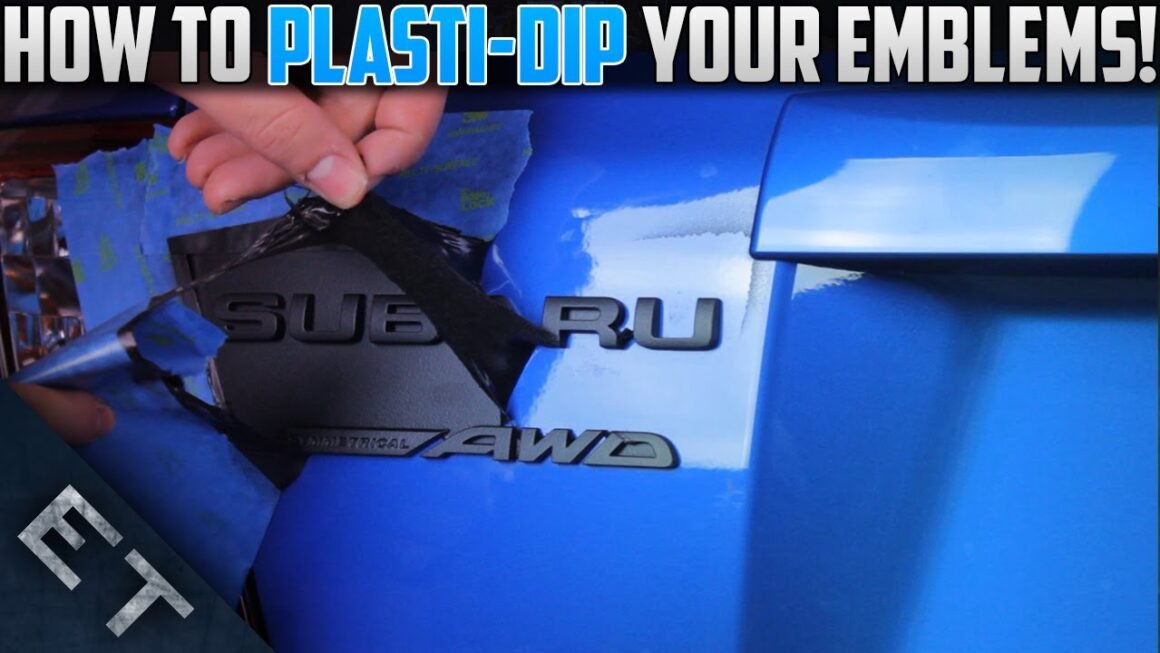When it comes to customizing your car with Plasti Dip, preparation is key to ensuring that the coating adheres properly and delivers a flawless finish. Many car enthusiasts and DIYers are turning to Plasti Dip for its versatility, ease of use, and ability to give your car a unique look without permanent commitment. However, to achieve the best results, you must know exactly what to do before applying Plasti Dip to your car.
This article covers everything you need to know about what to put on your car before Plasti Dipping it, including surface preparation, essential materials, common mistakes to avoid, and step-by-step instructions. Whether you’re a first-timer or a seasoned pro, this comprehensive guide will help ensure that your Plasti Dip application goes smoothly and results in a professional-quality finish.
What is Plasti Dip?
Before diving into the specifics of preparation, it’s important to understand what Plasti Dip is. Plasti Dip is a rubberized coating that can be applied to various surfaces, including metal, plastic, and even wood. It’s most commonly used in automotive applications for things like wheel rims, emblems, trim, and full vehicle wraps. The primary appeal of Plasti Dip is its ability to create a smooth, matte finish that is removable, making it perfect for car customization without long-term commitment.
Why Proper Preparation is Crucial Before Plasti Dipping Your Car
Plasti Dip’s durability and adhesion depend largely on how well the surface is prepped before application. If the surface isn’t cleaned, sanded, and primed properly, the Plasti Dip might peel, bubble, or fail to bond, leading to an unsatisfactory finish. Proper preparation ensures that the Plasti Dip adheres firmly to the surface, resulting in a smooth, long-lasting, and professional-looking finish.
What to Put on My Car Before I Plasti Dip It: A Complete List
Now that we’ve established the importance of preparation, let’s go over the essentials that you need to put on or use when preparing your car for Plasti Dip. The preparation process involves cleaning, masking, and priming, among other steps.
1. Clean the Surface Thoroughly
The first and most important step is to ensure the surface is free from dirt, grease, oil, and other contaminants. Plasti Dip requires a clean, dry surface to bond effectively. Here’s what you should use:
- Car Wash Soap: A mild car wash soap that won’t leave a residue is the best choice. Use warm water and a soft sponge to remove dirt and grime.
- Degreaser: For tougher contaminants, a degreaser or an automotive-specific cleaner can help break down any oils or grease on the surface.
- Microfiber Towels: These are ideal for drying the car and avoiding any scratching or damage.
2. Mask Areas You Don’t Want to Dip
Plasti Dip is designed to be sprayed, so it can easily get on areas you don’t want to cover, such as windows, tires, and chrome trim. To avoid overspray and protect these areas, use:
- Painter’s Tape: High-quality painter’s tape helps ensure clean lines and prevents overspray from getting on your car’s surface.
- Plastic Sheeting or Drop Cloths: These are used to cover large areas like windows, mirrors, or other parts you want to keep Plasti Dip-free.
3. Sand the Surface Lightly
For better adhesion, lightly sand the areas you plan to Plasti Dip. Sanding helps create a rough surface for the Plasti Dip to grip onto, ensuring that it stays in place. Use:
- Wet Sandpaper (400-600 grit): Wet sanding with fine-grit paper removes any small imperfections and smooths out the surface.
- Sanding Block: A sanding block helps maintain an even surface and avoids uneven pressure on the paint. What to put on my car before I Plasti Dip it, Plasti Dip preparation, car Plasti Dip steps, Plasti Dip tips
4. Apply Plasti Dip Primer (Optional but Recommended)
While Plasti Dip can adhere directly to clean surfaces, applying a primer specifically designed for Plasti Dip can enhance adhesion and improve the overall finish. A Plasti Dip primer helps:
- Increase Durability: It ensures that the Plasti Dip lasts longer and resists chipping and fading.
- Create a Uniform Surface: A primer will help create a uniform surface that prevents streaking and uneven coverage.
5. Use a Vinyl or Plastic Adhesion Promoter
If you’re applying Plasti Dip to areas that are made of plastic or rubber, consider using a vinyl/plastic adhesion promoter. This will increase the chances of a strong bond and reduce the risk of peeling or bubbling. Products like Plasti Dip Adhesion Promoter or 3M Adhesion Promoter are good choices.
Common Mistakes to Avoid Before Applying Plasti Dip
Even with the best preparation, mistakes can still happen if you’re not careful. Here are a few common mistakes to avoid when preparing your car for Plasti Dip:
1. Skipping the Cleaning Step
Cleaning the surface is crucial for adhesion. If you skip this step, you may end up with dirt or oil under the Plasti Dip, which can cause the coating to peel or bubble.
2. Not Using Enough Tape and Masking
Improper masking can lead to overspray on areas you don’t want to Plasti Dip. Always use painter’s tape and protective sheeting to cover windows, tires, and trim.
3. Rushing the Drying Process
Allow each layer of Plasti Dip to dry completely before applying the next coat. Rushing this step can cause the layers to blend together improperly and result in a sloppy finish.
4. Over-Sanding the Surface
While light sanding is necessary for better adhesion, over-sanding can damage the surface. Make sure to sand only enough to create a slight texture.
How to Apply Plasti Dip After Preparation
Once you’ve prepped your car, it’s time to apply the Plasti Dip. The application process is relatively simple, but it requires patience and attention to detail.
1. Shake the Can or Mix the Plasti Dip
If you’re using Plasti Dip spray cans, shake the can vigorously for a minute before spraying to ensure that the product is properly mixed. If you’re using Plasti Dip in a spray gun, ensure the product is mixed according to the manufacturer’s instructions.
2. Apply Thin, Even Layers
Start by applying thin coats of Plasti Dip to the surface. Apply each layer in a consistent, sweeping motion to avoid drips and uneven coverage. Wait about 10-15 minutes between coats to allow the product to dry.
3. Build Layers for Optimal Coverage
Apply at least 4-6 coats for a durable and professional-looking finish. The more layers you apply, the thicker the finish will be, which increases the durability of the Plasti Dip. What to put on my car before I Plasti Dip it, Plasti Dip preparation, car Plasti Dip steps, Plasti Dip tips
How Long Should You Wait Before Removing the Masking Tape?
After the final coat of Plasti Dip, let the product dry for at least 24 hours. You can remove the masking tape and protective sheeting after this period. It’s crucial to wait until the Plasti Dip is fully dry to prevent peeling or smudging.
What to Do After Plasti Dipping Your Car?
After applying the Plasti Dip, there are a few steps to follow to ensure the best results and the longevity of your coating.
1. Clean and Maintain the Plasti Dip Finish
To keep the Plasti Dip finish looking fresh, clean it regularly with a mild car soap and water. Avoid using harsh chemicals or abrasive sponges, as these can damage the coating. What to put on my car before I Plasti Dip it, Plasti Dip preparation, car Plasti Dip steps, Plasti Dip tips
2. Don’t Wax Plasti Dip
Waxing Plasti Dip is unnecessary and may even cause it to deteriorate. If you want to restore shine, use a Plasti Dip-specific cleaner or restorer.
Frequently Asked Questions (FAQs)
How long does Plasti Dip last on a car?
Plasti Dip can last anywhere from 1 to 3 years, depending on factors such as exposure to the elements and the quality of the application. Regular cleaning and maintenance can extend its lifespan.
Can Plasti Dip be removed?
Yes, one of the key benefits of Plasti Dip is that it is removable. If you want to change the color or remove it completely, you can peel it off without damaging the underlying surface.
Is Plasti Dip safe for all car surfaces?
Plasti Dip is safe for most car surfaces, including metal, plastic, and rubber. However, it is essential to follow the proper preparation steps for each surface type.
Can I use Plasti Dip on my car’s headlights or taillights?
It’s not recommended to use Plasti Dip on headlights or taillights because it can obscure the light output. However, you can use it on the trim or emblems.
Conclusion
Plasti Dipping your car is a great way to customize its appearance without making permanent changes. However, the key to achieving a professional-quality finish lies in the preparation. By cleaning, sanding, and masking your car properly, you can ensure that the Plasti Dip adheres well and lasts for years to come. With this guide, you now know exactly what to put on your car before applying Plasti Dip and how to do it right.
Remember, the more time and attention you give to the preparation process, the better the results will be. Happy Dipping!




